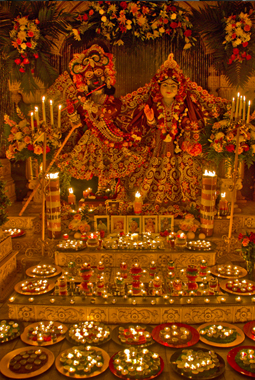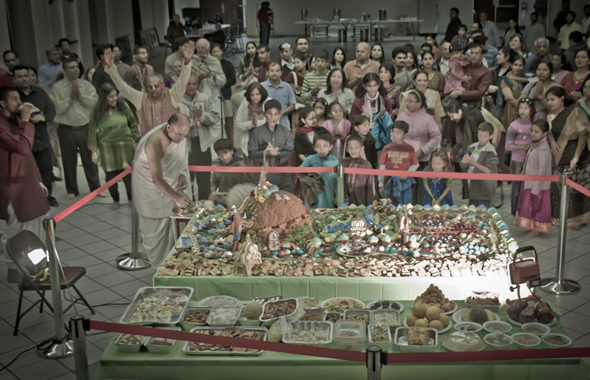Diwali & Govardhan Puja at ISKCON, Hare Krishna Dham, Houston
HOUSTON: In the Sanskrit language, “Deepawali” means a row or array of lights. Symbolizing the victory of good over evil, light over darkness, knowledge over ignorance, Deepawali (also known as Diwali) is celebrated all over the world with slightly different flavors. The ultimate message of the Lord’s unconditional mercy, grace, and love in protecting His devotees, however, remains undiluted.
In the northern part of India, Deepawali signifies the triumphant return of Lord Rama along with His consort Sita-devi, and brother Lakshmana, after they had spent nearly 14 years in exile and having overcome nearly impossible obstacles, finally culminating in the utter destruction of the demon-king Ravana along with his kingdom, Lanka. Ravana, an evil king who ruled Lanka, kidnapped Sita-devi and subsequently refused to hand Her over to the Lord, upon which a huge campaign was waged against his island-kingdom, resulting in Lord Rama emerging victorious and rescuing Sita-devi. People welcome back Lord Rama with a splendid display of beautifully-lit diyas, or earthern lamps. They clean and tidy their homes in anticipation of the Lord’s visit, prepare delicious sweets and savories, and light firecrackers to celebrate the joyous occasion.
In the southern part of India, Deepawali is about Lord Krishna’s victory over Narakasura, a notorious demon who would imprison devotees and torture them. Desperate and with nobody else to save them, they worshiped the Lord in full faith and He did not let them down. As Narakasura lay dying, the Lord, in His infinite mercy, asked him if he had a last wish, to which Narakasura replied, let this day be celebrated like no other. The Lord granted his wish and thus the day marks both Lord Krishna’s victory and liberation of the imprisoned devotees as well as a fulfillment of Narakasura’s last wish. Celebrations are quite similar to the North: people burst fire crackers, prepare sumptuous meals and traditional sweets, and immerse themselves in the spiritual nature of the occasion.
Jains and Sikhs also celebrate Deepawali, adding their own lovely touch in the process. This is what makes the entire country come alive – the melding of different faiths in the shared ecstasy of glorifying the Supreme.
In certain parts of India (such as Gujarat), the New Year is also welcomed on Deepawali day. In order to have an auspicious beginning to the New Year and start it with the blessings of Sri Sri Radha-NilaMadhava, hundreds of devotees traditionally attend the Mangal Aarti (at 4:30 AM) the following day (Monday, Nov 4, 2013).
Day after Deepawali, there is another major festival known as Govardhan Puja (also known as Anna Koot – meaning a mountain of food). This is mainly celebrated in the northern part of India, and is once again about how the Lord goes to great lengths to protect His devotees and those that have faith in Him. The story goes that the residents of Gokul used to worship Lord Indra, a demigod, so they’d be blessed with proper rains for their crops and cattle. Lord Krishna, observing the preparations for the worship of Indra, asked for an explanation. When informed that everyone depends on rains and Indra is the one who provides timely and nourishing rains, Lord Krishna said that in reality one ought to worship Govardhana, a hill in Vraj, Mathura, as it was both a source of food to the cows, a place for picnicking, and also one of the reasons the rains arrived on time. Upon His insistence, a fire-sacrifice was organized to worship Govardhan. Observing this, Indra became angry, and in a show of his fury, brought down a deluge upon the whole area. The terrified people sought the protection of Lord Krishna, who calmed them, and then simply lifted the entire hill with the little finger of His left hand! Under that huge “umbrella” the citizens were saved from the rising
waters. Indra continued to display his great anger for seven days before finally giving up. Lord Krishna in the meantime merrily continued to hold up the hill while the people continued to go about their daily duties. Finally, realizing his folly, Indra apologized deeply to the Supreme Personality of Godhead Sri Krishna, who, of course, forgave Indra’s folly. Since then, celebrating the importance of the sacred hill, people have to continue to worship Govardhan, who is just another manifestation of the Lord Himself. This is how the Lord came to acquire the name Giridhari (the one who held the Govardhan).
At ISKCON Hare Krishna Dham, both Deepawali (Nov 3, 2013, 5:30pm) and Govardhan Puja (Nov 4, 2013, 6:30pm) are celebrated with much enthusiasm!. And also there is public function on Nov 10, 5:00pm with drama, cultural events, Abhishek, candlelight aarti, melodious and spiritually uplifting kirtans and a discourse, followed by lovingly prepared prasadam. Featuring a very large number of bhoga (offering of food) to the Lord, this is the only day when food cooked by devotees is offered directly to their Lordships. There is no charge for any of these, but donations are most welcome.
Sponsorships are available for those interested:
Diwali Aarti: $201
Anna Koota Aarti: $251
Giriraj Aarti: $501
Hare Krishna Dham, 1320 W 34th St, Houston, Texas – 77018, Ph: (713) 686–4482, http://www.iskconhouston.org


